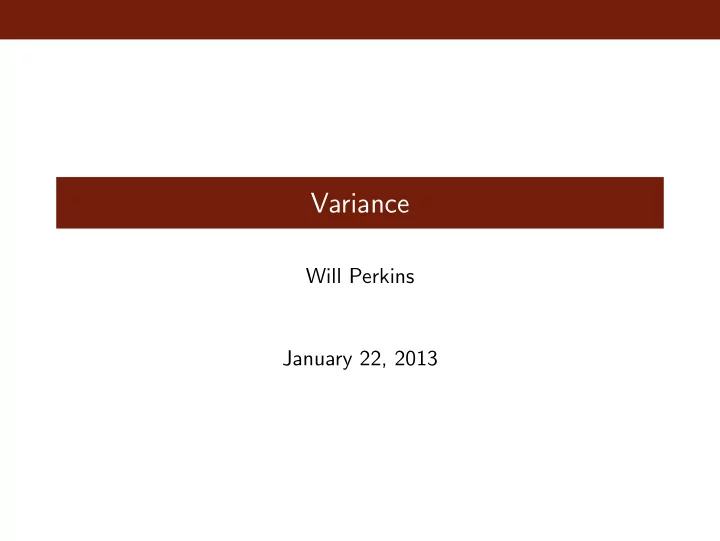

Variance Will Perkins January 22, 2013
Variance Definition The variance of a random variable X is: var( X ) = E [( X − E X ) 2 ] Alternatively, (check using linearity of expectation), var( X ) = E [ X 2 ] − ( E X ) 2
Variance Variance is a measure of how far a random variable typically deviates from its mean.
Moments Sometimes we refer to the mean and variance of a random variable as its first and second moments respectively. The k th moment of a random variable X is E [ X k ]. The k th moment about the mean or the k th central moment of X is E [( X − E X ) k ]. The variance is techincally the 2nd moment about the mean.
Examples Calculate the variance of the following random variables: 1 X ∼ Bin ( n , p ) 2 X ∼ Uniform [0 , 1] 3 X ∼ N (0 , 1)
Variance of Sums Unlike expectation, variance is not linear! var[ aX ] = a 2 var[ X ] var( X + Y ) =? Depends on the dependence. Give examples where var( X + Y ) is as high and as low as possible, relative to var( X ) and var( Y ).
Covariance We have one simple measurement of how two random variables depend on each other. Definition The covariance of X and Y is: cov( X , Y ) = E ( XY ) − E ( X ) E ( Y ) Note: 1 Covariance can be positive or negative. 2 cov( X , X ) = var( X )
Correlation If cov( X , Y ) = 0 we say that X and Y are uncorrelated . If cov( X , Y ) > 0 we say that X and Y are positively correlated . If cov( X , Y ) < 0 we say that X and Y are negatively correlated . Sometimes people mention the correlation of X and Y . This is defined as cov( X , Y ) corr ( X , Y ) = � var( X )var( Y ) Q: What are the units of correlation?
Variance of Sums While variance is not linear, we have a useful formula for computing variance of sums: var( X + Y ) = var( X ) + var( Y ) + 2cov( X , Y ) [Check that this is correct when X = Y ] And in general, n � � var( X 1 + . . . X n ) = var( X i ) + cov( X i , X j ) i =1 i � = j Note that the sum is over ordered pairs (which is why there is a factor 2 in the case of X + Y ).
Variance of Counting Random Variables When X is a counting random variable, we can use the decomposition of X = X 1 + · · · + X n into indicator random variables to simplify the calculation of var( X ). Let p i = Pr[ X i = 1] = E X i . Then E X = � p i . And � � p i − p 2 var( X ) = i + cov( X i , X j ) i i � = j
Variance of Counting Random Variables Using the definition of covariance, cov( X i , X j ) = Pr[ X i = 1 AND X j = 1] − p i p j So, � � p i − p 2 var( X ) = i + Pr[ X i = 1 AND X j = 1] − p i p j i i � = j
Examples For the random graph G ( n , p ), calculate The variance of the degree of a given vertex. The variance of the number of isolated vertices.
Recommend
More recommend